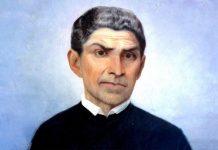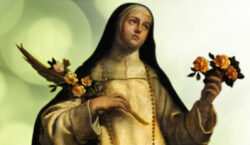God did not raise up a great preacher to save the Americas, but a woman endowed with a mission of universal character: Saint Rose of Lima.
Newsroom (24/08/2022 12:01 PM, Gaudium Press) Those who know the phrase: “Christ is my strength, prayer is my bulwark, faith is my shield” are inclined to judge it to be the saying of a medieval knight, the motto of a crusader full of religiousness, or even the testimony of a fearless and God-fearing warrior.
And there is nothing unreasonable in this judgement. For this fiery affirmation is part of one of the favourite prayers of a person who was in reality a fighter in the presence of the Most High, a conqueror of souls for God, a mystical warrior “seized by the inmost ardour caused by the nearness of Jesus Christ”.
– So who made such a fearless proclamation?
A maiden! A fragile, persistent, suffering, obedient, pure maiden. A young girl who, since she was a child, had a great inclination for prayer, meditation and service to the most needy. A young girl who, still as a girl, had her name changed because of her great beauty, fragility and gentleness. And who was she?
Isabel, who became the Rose of our Lady
Her baptismal name was Isabel Mariana de Jesus Paredes Flores y Oliva….
She was a descendant of Spanish conquistadors, she was the third of the eleven children of the prosperous couple Gaspar de Flores, a Spaniard who served the Viceroy of Peru as an archer, and Maria de Oliva, a distinguished lady who lived in Lima.
Isabel was born in the village of Quives, in the city of Lima, capital of Peru, on April 30th 1586. In her parents’ home lived an indiginous girl called Mariana. As a servant she helped Dona Maria de Oliva with the housework and was very helpful. One day when the whole family was gathered together, Mariana addressed Isabel exclaiming: “You’re as pretty as a rose!
The whole family heard the statement and all agreed with the faithful servant . From this came the nickname “Rosa”. Isabel’s extraordinary beauty led to the change of her name. Her mother herself, seeing that rosy, beautiful face, began to call her daughter “Rosa”. From Isabel she began to be called Rosa. And one day the girl herself showed how she would like to be called: Rosa de Santa Maria. Much later still, Isabel Mariana de Jesus Paredes Flores y Oliva became known throughout the world by the title that the Holy Church gave her: Rosa de Lima, or better still, Santa Rosa de Lima!
“Dedicate all your love to me…”
From her childhood Rose had a great tendency for prayer and meditation. She sought to see in the beauty of created things the reflections of God’s wisdom and goodness. And very early on she showed herself to be a predestined soul: she became a great devotee of Our Lady. At every moment she had recourse to the sure protection of the Holy Virgin Mother of God.
Rose grew up with the pious custom of praying before a picture of the Virgin Mary with the Child Jesus in her arms. One day, while absorbed in her prayers, the young girl heard a voice coming from the little image of Jesus:
– “Rose, dedicate all your love to me…”
She had no doubt: that call came from God. Hearing it, she made the decision to dedicate entirely to Our Lord an exclusive love. To Him alone would she dedicate her love; her love would be for Jesus alone. And so it was until the end of her days.
Her great beauty, together with the good training she had received and her reputation as the most virtuous and gifted girl in the city, led young men among the richest and most distinguished knights of Lima and its surroundings to take an interest in her and approach her with the legitimate and sincere desire to start a family. She, however, had already made a commitment to the Spouse of the Virgins. She took this very seriously and found her happiness in this commitment. That is why she used to say that “the pleasure and happiness that the world can offer me are simply a shadow compared to what I feel”.
In order to avoid any turning back from her decision to dedicate all her love to Jesus, so that she would not be a cause of temptation for the boys who saw her and also so that she herself would not be the target of temptations which would lead her to forget Our Lord’s request, Rose took a radical decision: she cut off her long, well-tended hair and began to cover her beautiful face with a veil.
Poor and without Rebellion
Rose’s family was well-off. Despite this, the father needed to work, including rendering services to the Viceroy, in order to maintain his economic and social position.
Due to the failure of a mining company in which Gaspar de Flores was engaged, his financial situation became compromised to such an extent that the family became poor, coming close to destitution. Therefore, Rose grew up in poverty and, while still in her teens, had to work hard to help her family.
She worked as a maid and, in addition, during the day she worked in the fields as a labourer and until late at night she sewed, embroidered, made lace and brocades in order to help support the household.
Rose, however, never stopped saying her prayers because of the work she had to do. She still found time to visit often the poor and the sick.
It is said of her that she was cheerful and knew how to play the harp gracefully and sing beautiful songs with a sweet and melodious voice.
Miracles, Afflictions and Missionary Spirit
Those who lived with her and those wrote her biography say that while she was still alive she was a great intercessor with God and through her mediation prodigious events and facts have been attributed. Among those who attest to her powerful intercession while she was still alive, we find Friar Juan de Lorenzana who, besides having known Rose, was her confessor. She had special gifts and charisms, he states.
To her are attributed miracles of healings, conversions, propitiations of rains and calming of the weather. All of them are unanimous in admitting that her prayers were what prevented Lima from being invaded by Dutch pirates in 1615.
Despite being graced with unusual mystical experiences and the gift of miracles, she never lacked hardship in life. Throughout her life, the cross was her inseparable companion. She took advantage of her crucified life to share, in a certain way, with the sufferings of the Divine Savior. These were sufferings which often came from gratuitous misunderstandings and unreasonable persecutions, not to mention physical sufferings, the acute pains caused by a prolonged illness which accompanied her to the end of her days.
Her sufferings seemed inexplicable. When she tried to express her pain she did not know how: “I can explain it only with silence” and she admitted: “I did not believe that a creature could be afflicted by such great sufferings”. Finally, the attitude she took showed that, out of love for God, she had a full acceptance of everything that was offered to her by Divine Providence: – “My God, you can increase the sufferings, as long as you increase my love for you”, she used to say, while praying.
Rosa was particularly devoted to Our Lady and prayed insistently to the Holy Mother of God for the growth of the Church, especially among the Indiginous Americans. So great was her apostolic love for the Natives that on one occasion she said that if she were not a woman, she would be a missionary among these souls who were also redeemed by the Blood of Our Lord Jesus Christ. As a missionary, she believed she could devote herself entirely to the salvation of them all, doing even more for them than she already did.
A Butterfly in Black and White
When she was old enough to marry, she chose instead to take a private vow of chastity. This, after struggling against the contrary desire of her parents. To satisfy a desire of her soul, she wanted to enter the convent of a religious order to live a life consecrated to God. She then chose the order she wished to enter. On the day of her admission, while praying before an image of Our Lady, she felt that she could not get up from where she was, not even with the help of her brothers. At that moment Rose realized that this could only be a warning from heaven: that she should not go to the convent that she was about to enter.
It was then that she prayed to Our Lady submitting herself entirely to the divine will. She would go wherever it was God’s will. This was enough for the paralysis to disappear completely and she immediately recovered her movements, standing up and walking without needing the help of the brothers. From that day onwards, Rose, who looked to Saint Catherine of Siena as a model to be followed, began to pray every day that, through her intercession, Our Lord would show her which religious order she should enter.
Every day, as she prayed, she noticed that, as soon as she began her prayers, a small butterfly appeared with the colours of black and white. Without disturbing Rose’s recollection and compenetration, the little creature would fly from one side to the other while she was praying.
For Rosa, this was another sign from God. And it was enough for the young girl to understand where she would best serve God and her brothers and sisters: she should enter the Third Order of the Congregation of Saint Dominic, whose garments were in black and white. The colours of the little butterfly that visited her daily were the same as those of the habit of St Catherine of Siena, the saint she had so much devotion to and so much desire to imitate. In 1606, at the age of twenty, she entered the Dominican Third Order.
She asked permission to take her religious vows at home rather than in a convent. Her request being accepted, she took her vows, thus officially becoming a member of the Order of St. Dominic. She also chose her religious name which became officially Rose: Rosa of Santa Maria.
In the garden and yard of her parents’ house, she built a hermitage. She built herself a small and narrow cell and began to lead a religious life of austerity, mortification and abandonment to God’s will. She practiced penance and punished her body with constant fasting, consuming the minimum amount of food necessary for survival. She hardly drank any water. Her bed was a board covered with a sack of burlap.
In the simplicity of her life as a lay woman, she was a model of a life of penance, of unblemished purity, of persevering prayer and of continuous spiritual and material service to her brothers and sisters. She wore painful sackcloths and it is said that she often used a silver ring similar to a crown of thorns. At a time when this was not common, Rose took Communion daily. She effectively purged all pride, self-love and vanity from her life, and the words of Christ were fulfilled in her: “He who humbles himself will be exalted”. She meditated often and when looking at the crucifix she would say:
– “Lord, Your cross is much crueler than mine”.
Within the austere, poor and joyful life she led, her heart soared. And in her contemplative flights she admired the beauty of things created in the image and likeness of the Creator and to Him she gave praise, honour and glory. A verse that she wrote herself and that she used to repeat as a prayer shows how her soul was and in what meditation she lived:
– My dear Lord, how good it is to see in the flowers, and in the shady green of the olive-tree, all your beauty. How sweet it is to know that you will bless me and fill my heart with joy!
In fact, by means of the simple path of abandonment to the will of God, she reached a high degree of contemplative life and mystical experience. She understood in depth the mystery of the Passion and Death of Our Lord Jesus Christ. Her prayers and penance succeeded in converting many sinners. Rosa de Santa Maria was extremely kind and charitable to all, especially to the Natives and blacks, to whom she rendered the most humble services in case of illness. She often visited the sick and the poor.
Eternal Nuptials and Canonization
Every year, on the Feast of Saint Bartholomew, Rose spent the whole day in prayer. When people asked her why that date made her so contemplative, more prayerful and more entrusted in God’s hands, she gave an answer which her listeners could not quite understand:
– “It is because this is the day of my eternal nuptials,” she would say.
Every 24th of August the event was repeated. And those around her continued to not understand. This went on until the year 1617. Rose had been suffering a serious illness which led them to insist on not leaving her. On Saint Bartholomew’s Day of that year she died. She was only 31 years old. As she had foretold, what she had predicted happened: the 24th August would be the day of her eternal encounter with God, the day of her “eternal wedding feast” with Our Lord Jesus Christ! Her last words were:
– “Jesus is with me!”
The whole of Peru mourned her death. Her burial was a great event. Her tomb, the places where she had lived and worked for the Church very soon became places of pilgrimage. Many miracles began to occur. Rosa de Santa Maria was beatified in 1667, in the first year of the pontificate of Pope Clement IX.
Her canonization took a little longer to come about. Pope Clement X was reluctant to raise her to the glory of the altars. But the Pope was convinced that he should canonize her after he witnessed a miraculous shower of rose petals that fell on him, which everyone attributed to the action of the Blessed Rose of St. Mary.
Clement X canonized her on 12 April 1671. Rose, the girl who had been confirmed by Saint Toribio of Mongrovejo, came to be known in the Catholic world as Saint Rose of Lima. She was the first woman in the Americas to receive such an exalted honour. Saint Rose of Lima is the patroness of Latin America and the Philippines.
Sources:
– (*) Joseph, Card. Ratzinger
– www.santarosadelima-rj.com.br/historia.htm (accessed 18/8/2011)
– www.santarosadelima-rj.com.br/historia.htm (accessed 18/8/2011)
– http://storico.radiovaticana.org/bra/storico/2010-08/417273_santa_rosa_de_lima_padroeira_da_america_latina.html
(Accessed 8/18/2011


































